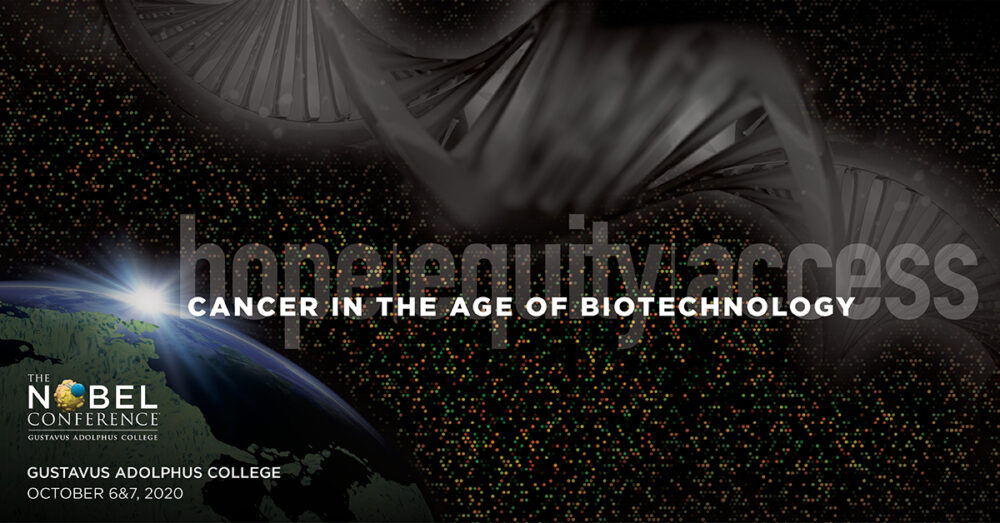
The move of Nobel Conference 56: Cancer in the Age of Biotechnology to an online format has opened the door to a new level of creativity from fine arts students involved with the conference.
While preparations for this year’s conference began well before COVID-19 hit, they continued to evolve right up until the performances were finalized in the last few weeks. From rehearsals moved online, to tightened recording schedules, to adjusted filming dates, these student choreographers, conductors, singers, and dancers embraced the experience as an opportunity to push themselves and find new ways to bring their work to life.
Social Justice Choir and Home
Home: An Examination of the Privilege to Live will be broadcast at 7:30 p.m. on October 6, following the first full day of speakers. The concert features the Gustavus Social Justice Choir and examines the inequities in the healthcare system, particularly surrounding cancer.
Co-Artistic Directors Michael McKenzie ’19 and Aleah Felton ’20 say they hope that the performance starts a dialogue and drives people to engage in creating change.
“So many people are going unvoiced and unnoticed,” Felton says. “I am hoping that this brings light and helps give people a voice who don’t necessarily feel like they have one. I also hope it helps bring people who have the power to make change to start having those conversations.”
McKenzie says that another goal was to make a point about representation in music. All of the communities represented compositionally are groups that have been marginalized by the healthcare system throughout history. While the traditional cannon of classical choral music has been dominated by white, male composers, McKenzie says that there were 10 versions of this concert’s repertoire list and in each version almost every piece was written by composers of color or women.
The 10 versions of the program were a result of the working and re-working of the concept as COVID took its toll. While McKenzie anticipated six months of in-person rehearsal, it ended up being months of zoom rehearsals, a condensed time table for rehearsing in person, and a recording session with masks, social distancing, and breaks every 30 minutes to let the air clear. While McKenzie was in complete support of the precautions taken, it did make things a bit more challenging. But in the end, the product is something he is exceedingly proud of.
“I am excited to see what people take away from it,” McKenzie says. “I think it depends what lens from their own life that they bring to it. So a scientist might see the cancer journey and how that plays out. A musician might see the musical equity piece. A lot of people will take away different things, but I hope they all feel motivated to fight for justice in their own spaces.”
Dance and Storytelling
As with past years of the Nobel Conference dance will also be involved. This year’s work is a series of dances that accompany the voices of cancer survivors telling their stories. The work will be aired Tuesday at approximately 2:25 p.m. and Wednesday at approximately 12:50 p.m. There will be a link available soon at the Nobel Conference website.
Similar to the challenges faced by McKenzie and Felton, choreographers Hannah Saunders ’22 and Claire Drapeau ’22 had to call upon their creativity as artists to bring this work to life.
The project began as a series of interviews through the nursing department as a way for students to understand how to care better for cancer patients. Saunders and Drapeau were both pre-med at the time, so it was a natural fit. They were invited to sit in on the interviews in January and were asked to put the words to dance.
“I feel like I learned a lot about their perseverance. It was really powerful to hear the cancer patient’s stories,” Drapeau says. “I’ve known people who have had cancer, but hearing people’s entire stories and the processes they went through was important. For Hannah and I it was a really big honor that we got to do this project.”
Because they were unable to work together in person, both choreographers would videotape their sections of the dance and piece them together before sending them to the dancers. Each of the dancers was chosen specifically because they reflected a part of the patient’s story.
“I hope the audience feels the emotion behind the dances. We tried to pick quotes that were empowering versus just trying to make you sad,” Drapeau says. “It’s a message of power and strength.”
Art at the Nobel Conference
There will be a virtual tour of the Hillstrom Museum of Art’s Cancer Never Had Me exhibit by Director of the Hillstrom Museum of Art Don Myers on Tuesday at 5:15 p.m.. The juried exhibit features the work of artists whose lives have been touched by cancer.
Directly following the virtual tour will be a gallery talk at 5:30 p.m. by artist Alison Hiltner about her work in the Schaefer Art Gallery’s current exhibit The Now and After, Works by Alison Hiltner.
More detailed information on both exhibits can be found here.